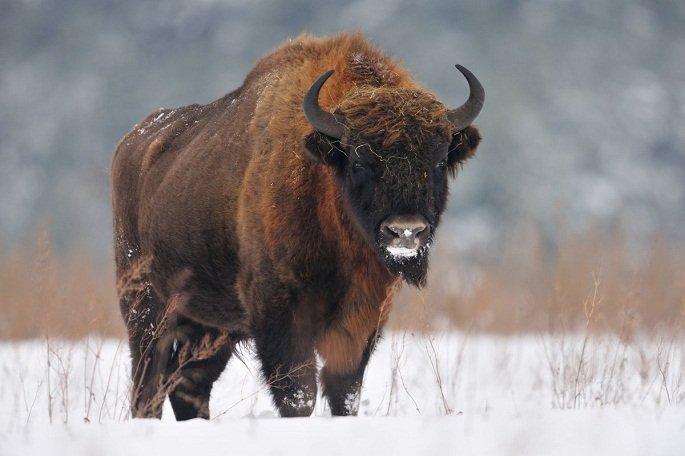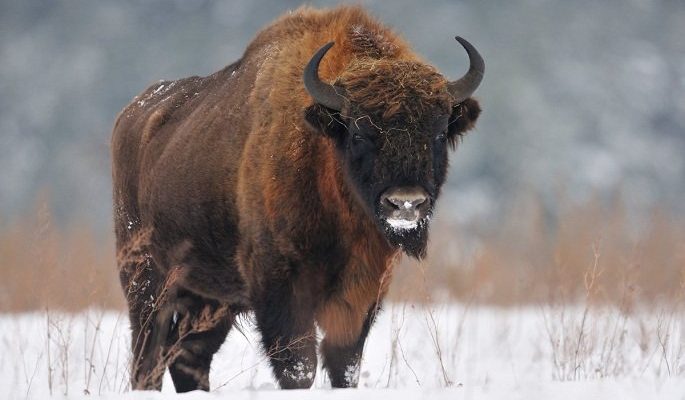
Let’s dive into some common myths and misconceptions about the European bison. Whether you’re a wildlife enthusiast or just curious about this majestic animal, dispelling these myths will help you appreciate the wisent even more. So grab a coffee, sit back, and let’s explore the truth behind this remarkable herbivore.
Myth 1: European Bison Are Just Smaller American Bison
Here’s the thing: while both are indeed bison, the European bison is not just a smaller version of its American relative. They are actually distinct species with their own unique traits. The European bison, which once roamed across Europe, is generally taller and a bit leaner than the American bison.
In terms of appearance, you might notice that wisents have a more pronounced shoulder hump, while American bison have a thicker build and a shaggy coat. This difference isn’t just about looks; it affects how they adapt to their environments. For instance, the wisent has developed to thrive in the forests of Europe, while American bison are more suited for the open grasslands.
Additionally, their social behaviors can differ. European bison tend to form smaller, more cohesive herds, while American bison often gather in larger groups. Each species has evolved to meet the challenges of its respective habitat, making them beautifully unique despite their similarities.
Myth 2: All European Bison Are Endangered
While it’s true that the European bison faced significant threats in the past, including overhunting and habitat loss, the situation has improved drastically over recent years. You might be surprised to learn that, thanks to concerted conservation efforts, the European bison is slowly making a comeback.
Various breeding programs have been implemented across Europe, so the population has steadily increased. In fact, they’ve been reintroduced into several regions where they had once disappeared. These efforts have not only revitalized local ecosystems but also helped raise awareness about the importance of biodiversity.
However, it’s important to note that their status can change based on factors like habitat preservation and poaching. So while the European bison is no longer on the brink of extinction, it still requires our attention and protective measures.
Myth 3: European Bison Are Aggressive and Dangerous
You might be wondering if European bison are as dangerous as they look. It’s common to think that large animals, especially those with horns, are aggressive. While bison can be protective of their young and may charge if they feel threatened, they aren’t naturally aggressive animals. In fact, wisents tend to be quite shy and will often avoid human interaction.
When given space, these animals are more likely to graze peacefully than engage in aggressive behavior. Just picture a big dog—you know, the kind that looks intimidating but just wants to play fetch. Similarly, European bison prefer to keep to themselves rather than confront potential threats.
Of course, it’s vital to respect their space if you ever find yourself observing them in the wild or in a sanctuary. Like any wild animal, they can be unpredictable if provoked.
Myth 4: European Bison Only Live in National Parks
It might feel like the only place you can see a European bison is in a national park, but that’s not entirely true. While many wisents are indeed protected within national parks and wildlife reserves, they can also be found in various habitats across Europe, including forests, grasslands, and some agricultural areas.
Many conservation programs work to integrate bison back into ecosystems where they can roam freely. This rewilding initiative helps support biodiversity by allowing these herbivores to interact with other species, maintaining the natural balance of their environment.
So, if you’re keen to spot a European bison, your best bet might just be taking a stroll through certain forests or reserves where they thrive rather than being limited to tourist-heavy parks.
Myth 5: European Bison Are Extinct in the Wild
It’s easy to assume that if an animal is rare, it must be extinct in the wild. Thankfully, that’s not the case for the European bison. As mentioned earlier, these magnificent creatures are not only surviving but also thriving in specific areas.
Thanks to conservation efforts, several populations are now living in their natural habitats across Europe. Today, you can find them in places like Poland’s Białowieża Forest, where they roam freely. It’s almost like seeing a piece of history come alive, isn’t it?
Moreover, ongoing efforts aim to expand their range and increase genetic diversity, further ensuring the future of these animals. This perseverance is a testament to how dedicated people are to preserving our natural world.
Myth 6: European Bison Cannot Adapt to Changing Environments
Another common misconception is that European bison are inflexible and cannot adapt to changes in their environment. In reality, these animals are quite resilient. Like many species, they have evolved over thousands of years to thrive in various habitats.
The key to their survival often lies in their foraging behavior. European bison are adaptive grazers and can switch between grazing on grasses and browsing on bushes and tree leaves, depending on what’s available. This adaptability helps them make the most of their environment, ensuring they can find food, even in tougher times.
So, while drastic climate changes do pose challenges, these bison have historically shown a remarkable ability to adjust to different conditions, making them more resilient than many people give them credit for.
As we’ve explored, there are many myths and misconceptions about the European bison that can cloud our understanding of this incredible creature. From their unique traits and conservation status to their social behaviors, the more we learn, the more appreciation we can cultivate for the wisent.
Understanding the facts not only enriches our knowledge but also empowers us to take part in conversations about conservation efforts and wildlife protection. So, whether you’re hiking in Europe or simply sharing with friends, remember the real story behind the European bison. They’re not just a part of history; they’re a vital piece of our current and future ecosystems. Let’s keep championing their existence—because every bit of awareness makes a difference!

